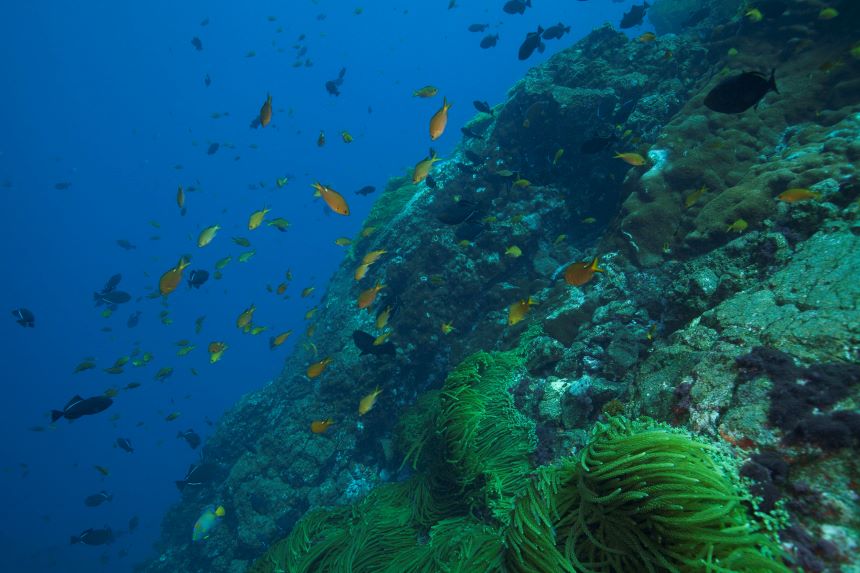


Undersea cliff, St Peter and St Paul Archipelago, about 1,000 km off the coast of Brazil (photo: Enrico Marone)
Published on 02/19/2024
By José Tadeu Arantes | Agência FAPESP – With more than 10,000 kilometers (km) of coastline and a marine area of 5.7 million km², equivalent to two-thirds of its land area, Brazil is one of the world’s major ocean-facing countries. The marine area, suggestively known as the “Blue Amazon”, is home to huge biodiversity and a wide array of habitats. About 18% of the Brazilian population live on the coastal strip, which also contains 13 of Brazil’s 26 state capitals. Economic activities associated with the ocean and coastline account for 20% of its GDP.
However, the coast and territorial waters are increasingly impacted by human activity. The main causes of biodiversity and ecosystem service loss in this region are disorderly occupation and land use changes that damage or destroy mangroves, salt marshes, lagoons and other natural features, eroding the shore and eliminating habitats; pollution by plastic, industrial waste, fertilizer and sewage; overfishing and marine resource mismanagement, leading to a rise in the number of endangered species, the collapse of fish stocks, and food insecurity; the introduction of invasive exotic species; and climate change.
To counteract this trend effectively and, as the authors say, “help lift the veil that makes the ocean invisible”, the Executive Summary of the First Brazilian Diagnosis of Coastal and Marine Biodiversity and Ecosystem Services was launched on November 23, 2023. Produced by the Brazilian Platform on Biodiversity and Ecosystem Services (BPBES) and the UNESCO Chair for Ocean Sustainability, the document presents the most comprehensive survey of Brazilian coastal and marine biodiversity and ecosystem services conducted to date. It is available online, in Portuguese, at: www.bpbes.net.br/produto/diagnostico-brasileiro-marinho-costeiro/.
According to Cristiana Simão Seixas, a researcher with the Center for Environmental Research (NEPAM) at the State University of Campinas (UNICAMP) and one of the principal investigators for the First Diagnosis, “The main merit of the Summary is that it assembles all the information available in a systematic manner for use by administrators in the public and private sectors, civil society organizations and the general public, as a basis for new attitudes, and as a contribution to the creation of a social force that acts to bring about change.”
The Summary was written by 53 academic and government specialists, 12 young researchers, and 26 representatives of Indigenous and traditional communities. “The process involved a lot of dialogue with public-sector players, such as the Interministerial Commission for Marine Resources [CIRM], and with civil society,” said Alexander Turra, also one of the principal investigators for the First Diagnosis. Turra is a professor at the University of São Paulo’s Oceanographic Institute (IO-USP) and coordinator of the UNESCO Chair for Ocean Sustainability.
In calling attention to losses to the quality of life and the economy due to deterioration of the ocean and coastal zone, the report emphasizes the degree to which we all depend on them, wherever we live. “As a major carbon sink, the ocean plays a key role in climate regulation,” said Beatrice Padovani, a professor of oceanography at the Federal University of Pernambuco (UFPE) and another principal investigator for the First Diagnosis. While millions of people’s livelihoods derive from the ocean and coastal strip, inhabitants of the hinterland are also connected to them via a complex supply chain responsible for food, water and energy security, access to mineral and biotechnological resources, and aesthetic and spiritual enjoyment of the seascape.
“We’ve seen the emergence of a major grassroots movement in defense of the ocean and coastal environment in recent years. It’s led by Indigenous and traditional communities, but we believe other social actors, such as business leaders in the tourism industry, for example, should also be aware that protecting the quality of the ocean and conservation of the coastline are essential to their economic activities,” Turra said. The document presents proposals for promoting “a prosperous, effectively protected ocean used in a fair, equitable and environmental sustainable manner”.
The Summary addresses the theme of governance from a multiple perspective that takes into account the diversity of sectors, ethnic groups, genders and generations. It recognizes the value of their complementary stores of knowledge and promotes the concept of “ocean culture” embodied by a global movement to heighten awareness of the ocean’s influence on people’s lives and the impact of human action on the ocean while fostering knowledge exchange and reconnection with the marine environment.
Multilateral initiatives such as the Decade of Ocean Science for Sustainable Development 2021-30 (the Ocean Decade) and Sustainable Development Goal (SDG) 14, Life Below Water, both established by the United Nations, are reference frameworks for the report and the national actions it recommends.
FAPESP contributed to the First Brazilian Diagnosis of Coastal and Marine Biodiversity and Ecosystem Services by awarding scholarships and research grants to several of the scientists involved in producing the document, under the aegis of its Research Program on Biodiversity Characterization, Conservation and Sustainable Use (BIOTA-FAPESP).
The Summary for Policymakers is at: www.bpbes.net.br/produto/diagnostico-brasileiro-marinho-costeiro/.
Source: https://agencia.fapesp.br/50877